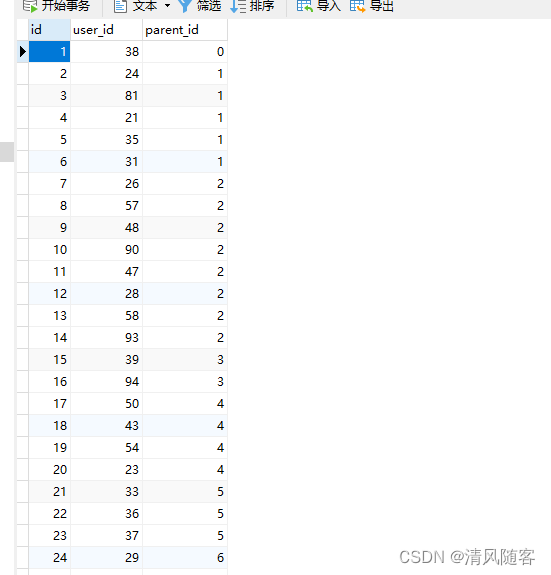递归工具类:
import java.util.List;
import java.util.stream.Collectors;
/**
* 通用属性结构工具类
*/
public class TreeUtils {
/**
* 通过父亲id=0 从一级开始往下排的方法
*/
public static <T> List<T> bulidTree(List<T> list) {
//通过反射拿到一级分类
List<T> root = list.stream().filter(item -> (Long) ReflectionUtils.getFieldValue(item, "parentId") == 0).collect(Collectors.toList());
list.removeAll(root);
root.forEach(item->{
getChildren(item,list);
});
return root;
}
/**
* 递归 找孩子
*/
public static <T> void getChildren(T t, List<T> list) {
if (hasChildren(t,list)){
List<T> collect = list.stream().filter(item -> (Long) ReflectionUtils.getFieldValue(item, "parentId") == (Long) ReflectionUtils.getFieldValue(t, "id")).collect(Collectors.toList());
ReflectionUtils.setFieldValue(t,"children",collect);
list.removeAll(collect);
//遍历二级
collect.forEach(item1->getChildren(item1,list));
}
}
/**
* 判断有没有孩子
*/
public static <T> boolean hasChildren(T t, List<T> list) {
//使用anyMath 来判断
return list.stream().anyMatch(item -> {
long a = (Long) ReflectionUtils.getFieldValue(item, "parentId");
long b = (Long) ReflectionUtils.getFieldValue(t, "id");
return a == b;
});
}
}
反射工具类:
import lombok.extern.slf4j.Slf4j;
import java.lang.reflect.*;
@Slf4j//lombok中的日志
public class ReflectionUtils {
/**
* 反射调用方法
*/
/**
* 直接读取对象的属性值, 忽略 private/protected 修饰符, 也不经过 getter
*
* @param object
* @param fieldName
* @return
*/
public static Object getFieldValue(Object object, String fieldName) {
Field field = getDeclaredField(object, fieldName);
if (field == null) {
throw new IllegalArgumentException("Could not find field [" + fieldName + "] on target [" + object + "]");
}
makeAccessible(field);
Object result = null;
try {
result = field.get(object);
} catch (IllegalAccessException e) {
log.error("getFieldValue:", e);
}
return result;
}
/**
* 直接设置对象属性值, 忽略 private/protected 修饰符, 也不经过 setter
*
* @param object
* @param fieldName
* @param value
*/
public static void setFieldValue(Object object, String fieldName, Object value) {
Field field = getDeclaredField(object, fieldName);
if (field == null) {
throw new IllegalArgumentException("Could not find field [" + fieldName + "] on target [" + object + "]");
}
makeAccessible(field);
try {
field.set(object, value);
} catch (IllegalAccessException e) {
log.error("setFieldValue:", e);
}
}
/**
* 通过反射, 获得定义 Class 时声明的父类的泛型参数的类型
* 如: public EmployeeDao extends BaseDao<Employee, String>
*
* @param clazz
* @param index
* @return
*/
@SuppressWarnings("unchecked")
public static Class getSuperClassGenricType(Class clazz, int index) {
Type genType = clazz.getGenericSuperclass();
if (!(genType instanceof ParameterizedType)) {
return Object.class;
}
Type[] params = ((ParameterizedType) genType).getActualTypeArguments();
if (index >= params.length || index < 0) {
return Object.class;
}
if (!(params[index] instanceof Class)) {
return Object.class;
}
return (Class) params[index];
}
/**
* 通过反射, 获得 Class 定义中声明的父类的泛型参数类型
* 如: public EmployeeDao extends BaseDao<Employee, String>
*
* @param <T>
* @param clazz
* @return
*/
@SuppressWarnings("unchecked")
public static <T> Class<T> getSuperGenericType(Class clazz) {
return getSuperClassGenricType(clazz, 0);
}
/**
* 循环向上转型, 获取对象的 DeclaredMethod
*
* @param object
* @param methodName
* @param parameterTypes
* @return
*/
public static Method getDeclaredMethod(Object object, String methodName, Class<?>[] parameterTypes) {
for (Class<?> superClass = object.getClass(); superClass != Object.class; superClass = superClass.getSuperclass()) {
try {
return superClass.getDeclaredMethod(methodName, parameterTypes);
} catch (NoSuchMethodException e) {
//Method 不在当前类定义, 继续向上转型
}
}
return null;
}
/**
* 使 filed 变为可访问
*
* @param field
*/
public static void makeAccessible(Field field) {
if (!Modifier.isPublic(field.getModifiers())) {
field.setAccessible(true);
}
}
/**
* 循环向上转型, 获取对象的 DeclaredField
*
* @param object
* @param filedName
* @return
*/
public static Field getDeclaredField(Object object, String filedName) {
for (Class<?> superClass = object.getClass(); superClass != Object.class; superClass = superClass.getSuperclass()) {
try {
return superClass.getDeclaredField(filedName);
} catch (NoSuchFieldException e) {
//Field 不在当前类定义, 继续向上转型
}
}
return null;
}
/**
* 直接调用对象方法, 而忽略修饰符(private, protected)
*
* @param object
* @param methodName
* @param parameterTypes
* @param parameters
* @return
* @throws InvocationTargetException
* @throws IllegalArgumentException
*/
public static Object invokeMethod(Object object, String methodName, Class<?>[] parameterTypes,
Object[] parameters) {
try {
Method method = getDeclaredMethod(object, methodName, parameterTypes);
if (method == null) {
throw new IllegalArgumentException("Could not find method [" + methodName + "] on target [" + object + "]");
}
method.setAccessible(true);
return method.invoke(object, parameters);
} catch (Exception e) {
log.error("invokeMethod:", e);
}
return null;
}
}
查找树桩结构时候,需要实体类增加字段获取children 数组
/**
* 是否有孩子
*/
Boolean hasChildren;
/**
* 孩子 树状结构
*/
List<DeptVo> children;
/**
* 是否是叶子节点 结果和hasChildren相反的值
*/
Boolean isLeaf;
数据库设计:























 1255
1255











 被折叠的 条评论
为什么被折叠?
被折叠的 条评论
为什么被折叠?








